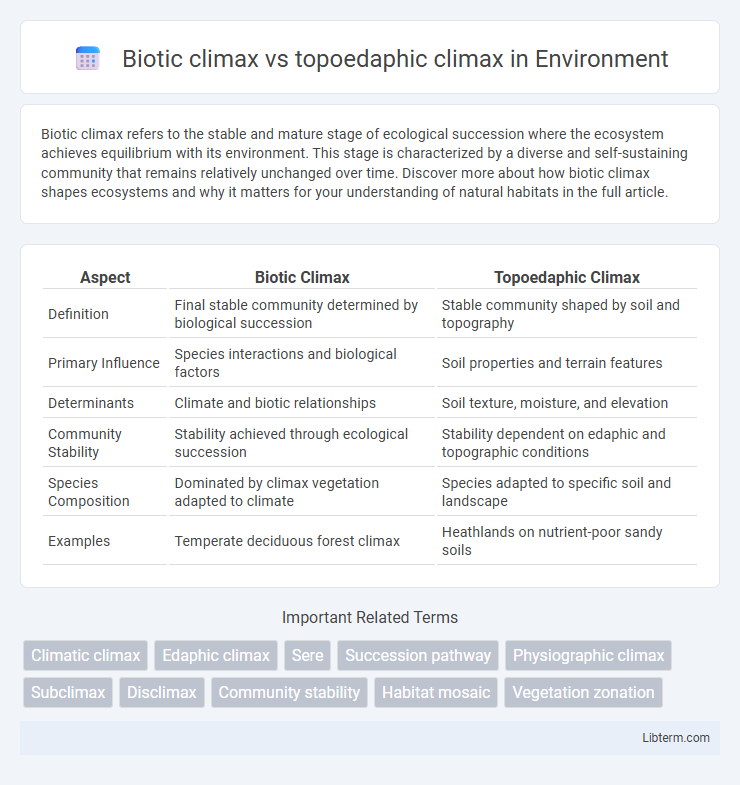Biotic climax refers to the stable and mature stage of ecological succession where the ecosystem achieves equilibrium with its environment. This stage is characterized by a diverse and self-sustaining community that remains relatively unchanged over time. Discover more about how biotic climax shapes ecosystems and why it matters for your understanding of natural habitats in the full article.
Table of Comparison
| Aspect | Biotic Climax | Topoedaphic Climax |
|---|---|---|
| Definition | Final stable community determined by biological succession | Stable community shaped by soil and topography |
| Primary Influence | Species interactions and biological factors | Soil properties and terrain features |
| Determinants | Climate and biotic relationships | Soil texture, moisture, and elevation |
| Community Stability | Stability achieved through ecological succession | Stability dependent on edaphic and topographic conditions |
| Species Composition | Dominated by climax vegetation adapted to climate | Species adapted to specific soil and landscape |
| Examples | Temperate deciduous forest climax | Heathlands on nutrient-poor sandy soils |
Introduction to Ecological Climaxes
Ecological climaxes represent stable communities where ecosystems reach equilibrium through species interactions and environmental factors. Biotic climax occurs when living organisms, especially dominant vegetation, drive the ecosystem's final stable state, reflecting successional stages shaped by species competition and adaptation. Topoedaphic climax depends primarily on soil types and topography, where abiotic conditions such as soil moisture, texture, and nutrient availability dictate the climax community structure and composition.
Definition of Biotic Climax
Biotic climax refers to the final and stable community in ecological succession, determined primarily by biological factors and interactions among species. It represents an ecosystem where species composition remains relatively unchanged over time, shaped by intrinsic biological processes like competition and symbiosis. In contrast, topoedaphic climax is influenced by topography and soil conditions, emphasizing the role of abiotic environmental factors in establishing the climax community.
Definition of Topoedaphic Climax
Topoedaphic climax refers to a stable ecological community influenced primarily by the site's topography and soil conditions, rather than solely by biological succession. Unlike a biotic climax, which is determined by the dominant vegetation and biological factors, the topoedaphic climax emphasizes the role of physical environmental factors such as slope, drainage, and soil composition in shaping the climax community. This concept highlights how abiotic conditions can limit or direct the development of ecosystems toward distinct, site-specific climax communities.
Key Differences Between Biotic and Topoedaphic Climaxes
Biotic climax refers to a stable ecosystem defined by the climax community driven primarily by biological interactions and species composition, whereas topoedaphic climax is determined by local environmental factors such as soil type, topography, and moisture conditions. Key differences include the biotic climax's dependency on successional processes and species competition, while the topoedaphic climax is shaped by abiotic factors influencing vegetation tailored to specific microhabitats. Biotic climax communities evolve toward maximum biomass and diversity, whereas topoedaphic climax communities are limited and structured by the physical and chemical properties of the landscape.
Factors Influencing Biotic Climaxes
Biotic climax communities are influenced primarily by factors such as species interactions, competition, predation, and successional dynamics within an ecosystem, shaping which species dominate over time. In contrast, topoedaphic climax communities depend largely on soil properties, topography, moisture levels, and microclimate variations that govern vegetation patterns. Understanding these biotic influences helps ecologists predict ecosystem stability and resilience in response to environmental changes.
Environmental Controls on Topoedaphic Climaxes
Environmental controls on topoedaphic climaxes are primarily dictated by soil properties, topography, and microclimatic conditions, which influence species composition and community development independently of successional stage. Unlike biotic climaxes determined by vegetation succession and interspecific competition, topoedaphic climaxes result from persistent environmental factors such as soil fertility, moisture gradients, and drainage patterns. These controls create stable plant communities adapted to specific edaphic conditions, maintaining climax states despite potential biotic changes.
Examples of Biotic Climax Communities
Biotic climax communities consist of stable ecosystems where the dominant plant and animal species maintain equilibrium, such as oak-hickory forests in eastern North America and tropical rainforests in the Amazon Basin. These communities are shaped primarily by biological interactions rather than abiotic factors, contrasting with topoedaphic climax communities that depend on soil and topography. Other examples include European beech forests and California chaparral, which reflect species assemblages maintained by internal ecological processes.
Examples of Topoedaphic Climax Vegetation
Topoedaphic climax vegetation develops under specific soil and topographic conditions, resulting in diverse plant communities such as pine barrens on sandy, acidic soils or oak-hickory forests on well-drained upland sites. Unlike biotic climax communities driven primarily by biological interactions, topoedaphic climax vegetation reflects a stable endpoint determined by abiotic factors like soil texture, moisture gradients, and slope position. These ecosystems include examples like alpine meadows on mountain slopes, where soil drainage and exposure govern plant species composition, demonstrating the influence of edaphic environment in climax formation.
Ecological Significance of Climax Concepts
Biotic climax represents the stable community resulting from biological interactions and successional processes, reflecting the climax of ecological development under specific climatic conditions. Topoedaphic climax incorporates the influence of site-specific topography and soil factors, highlighting the local environmental controls on community stability. Understanding both climax concepts is essential for ecosystem management and conservation, as they reveal how biotic and abiotic factors drive long-term ecological equilibrium and biodiversity patterns.
Implications for Conservation and Land Management
Biotic climax refers to a stable ecosystem state dominated by species interactions and community dynamics, while topoedaphic climax is determined primarily by soil and topographic conditions influencing vegetation patterns. Understanding the distinction is crucial for conservation, as protecting biotic climax areas prioritizes maintaining species diversity and ecological processes, whereas managing topoedaphic climax sites emphasizes soil health and landscape heterogeneity. Effective land management strategies integrate both concepts to promote ecosystem resilience and biodiversity conservation in varying environmental contexts.
Biotic climax Infographic

 libterm.com
libterm.com